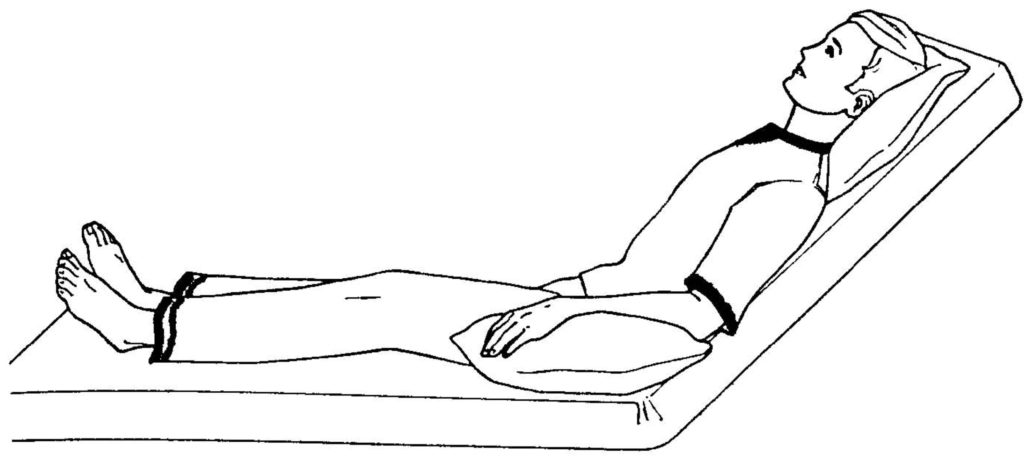What Are the Different Fowler Positions?
Fowler’s position is known as the “standard patient’s position,” and was invented by George Ryerson Fowler. Certified registered nurses are trained in their RN programs to recognize this type of patient position because it provides the most comfort. The technique is used for a variety of reasons, including:
- Patient feeding through oral and gastric means;
- Radiology;
- X-rays that are taken from the side of the bed;
- When the patient faces difficulty breathing or is undergoing breathing treatment;
- When drainage occurs from after abdominoplasty;
- And for general grooming.
In the standard Fowler’s position, the patient sits upright at an angle between 30 and 90 degrees. The legs of the patient are either bent at the knees or laid out straight on the bed. The position is preferred as an option to combat respiratory distress syndrome since it allows for better chest expansion and improves breathing by facilitating oxygenation. For patients who are incapable of moving, this position enables normal talking, eating, and supports easy swallowing aided by gravity.
There are three variants to take note of aside from the standard Fowler’s position: the semi-Fowler’s position, low-Fowler’s position, and high-Fowler’s position. The requirements of the patient and their medical conditions will determine which variant of Fowler’s position should be applied. Understanding the different Fowler’s positions and when each is appropriate is an important way nurses can fulfill the metaparadigm of nursing, tending to the patient’s health, person, environment, and nursing needs.
Semi-Fowler’s Position
A semi-Fowler’s position is similar to the standard Fowler’s position, however, the head and back rest at a lower angle. The bed is typically inclined at an angle of 15 to 45 degrees, although 30 degrees is most frequently used. This position is implemented for a number of medical reasons including:
- Feeding;
- Lung expansion;
- To decrease cardiac or respiratory conditions;
- After shoulder, nasal, cranial, abdominal and breast reconstruction surgeries;
- For patients with a nasogastric tube.
Semi-Fowler’s is considered the most comfortable position for patients who have a nasogastric tube fitted, as it ensures the tube remains fixed in its place. Additionally, the semi-Fowler’s position is also used for pregnancy because it improves the mother’s comfort.
This variation of Fowler’s is considered the most popular. Patients resting in a semi-Fowler’s position experience less nausea compared to patients lying down. Typically, it is recommended for patients undergoing treatments that trigger nausea, such as chemotherapy. According to a study, the patients who were administered with chemotherapy in a semi-Fowler’s position experienced comparatively less severe nausea.
Low-Fowler’s Position
This position is similar to the supine position, and is considered the best position for rest. In a low-Fowler’s position, the patient’s head is inclined at a 15- or 30-degree angle. This position is typically used:
- After a procedure;
- To reduce lower back pain;
- To administer drugs;
- To prevent aspiration during tube feeding.
High-Fowler’s Position
In this position, the patient is upright and the spine is kept straight. The upper part of the body is angled between 60 to 90 degrees with respect to the lower portion of the body. While allowing for easy breathing, this is also considered the best position for:
- Defecating;
- Easy breathing;
- Eating;
- Swallowing;
- Taking x-rays.
Patients in an older age group generally spend more time resting in their beds, which is why they often face problems associated with digestion and respiration. A high-Fowler’s position is typically prescribed to elderly patients as it is scientifically proven to aid the digestion process and also helps the person to overcome breathing problems.
However, it also has risks associated with it as the studies have revealed that resting in a high-Fowler’s position can cause discomfort including pressure on the sacral and gluteal areas, and makes patients prone to the development of pressure ulcers.
Benefits and Drawbacks of Fowler’s Position
Fowler’s position has become so widely used that it is among the basic skills all RNs must learn as part of their training. Besides creating more comfort for the patient, Fowler’s position has other advantages, including:
- Better surgical exposure;
- Increased drainage of blood and cerebral spinal fluid;
- Increased homeostasis;
- Improved breathing;
- Relaxed abdominal muscles.
There are also drawbacks to the Fowler’s position including:
- A decrease in the return of blood to the heart;
- An increased risk of venous embolism;
- An increase in air or gas inside the skull;
- An increased potential for airway loss, nerve damage, facial edema, pneumocephalus, and quadriplegia;
Patient comfort is important and vital to safe and effective surgical procedures, and part of a nurse’s job is to attend to each patient’s unique needs for safety and comfort. Understanding a patient’s comfort level, length of procedure, and medical devices needed can help nurses identify and maintain the best position for the patient.
Further Resources:






